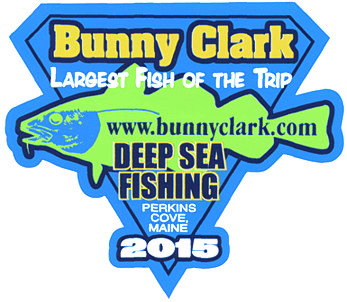
The 2016 Bunny Clark Guestletter
Annual Review of the 2015 Bunny Clark Fishing Season & the Plans & Outlook for the 2016 Season.
January 15, 2016

Dear Guests:
Welcome back to another end of season edition of the annual Bunny Clark Guestletter.
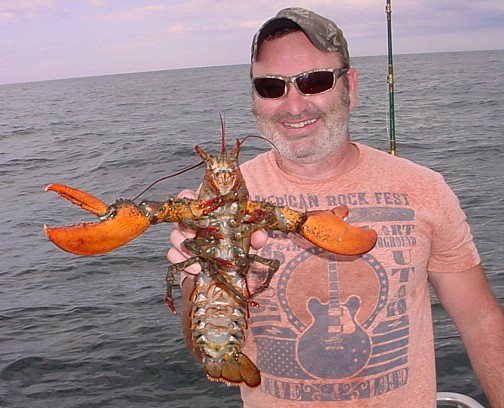 At the end of the 2014 fishing season, I had already decided that we were going to have to re-power if the Bunny Clark was to continue on into the future in the party fishing business. The present engine was going to be nineteen years old, had become obsolete only a couple of years after I bought it, parts were less available in the United States and the thoughts of being broken down for days were just too much to consider. Worries at that time were the cost of the engine, the added costs of reconfiguring the space in the engine room where it would reside, the added costs you never expect to incur and the time it would take to complete the project exactly the way I wanted it. So I spent most of November deciding on an engine and all of December 2014 working on bringing the engine from overseas to the Bunny Clark site. So logistics and funding were the challenges at that time.
At the end of the 2014 fishing season, I had already decided that we were going to have to re-power if the Bunny Clark was to continue on into the future in the party fishing business. The present engine was going to be nineteen years old, had become obsolete only a couple of years after I bought it, parts were less available in the United States and the thoughts of being broken down for days were just too much to consider. Worries at that time were the cost of the engine, the added costs of reconfiguring the space in the engine room where it would reside, the added costs you never expect to incur and the time it would take to complete the project exactly the way I wanted it. So I spent most of November deciding on an engine and all of December 2014 working on bringing the engine from overseas to the Bunny Clark site. So logistics and funding were the challenges at that time.
[The picture on the right is a shot I took of Bruce Fortier (NH) holding his 2.5 pound female "V" tailed lobster, the largest lobster caught on the Bunny Clark last season. Even a lobsterman can't keep a "V" notched lobster as it means that at the time the "V" was made the lobster was bearing eggs under the tail. By law, a female lobster with a "V" has to be released until, through subsequent moltings, the "V" disappears. It can take as long as four years or more in some cases with bigger lobsters.]
When the new year of 2015 arrived, other challenges occurred. First, the new engine was not going to arrive until the end of February. This meant I would need extra resources and funding to get the engine ready on time. Second, the recreational angling community would be facing some serious cuts in the take of certain species of groundfish, cod and haddock specifically. Where during the 2014 fishing season the cod minimum size limit was nineteen inches with a nine (9) cod bag limit per angler, the New England Fishery Management Council (the board that advises the National Marine Fisheries Service) was talking about a prohibition of cod for anglers in the new year of 2015. A prohibition to even fish in some of our better fishing grounds was also being discussed as an option! Where during the 2014 fishing season there was an unlimited bag limit on haddock with a minimum size limit of twenty-one (21) inches, the Council was talking of a prohibition of landing haddock during the season! These proposed regulations would have serious consequences on a business, like mine, that was built on the take of cod and haddock!
Needless to say, with the new engine and the prospects of serious landings reductions for my angling patrons, I was worried. In fact, I thought; "What have I committed to?"
The regulations that did come out before the season were pretty bad but they weren't as onerous as they could have been. Thanks in large part to Frank Blount, a Council member who owns the Francis (deep sea fishing) Fleet out of Point Judith, RI, the area closures that were suggested for recreational anglers didn't happen. I don't think the powers-that-be at NMFS were very pleased about this decision by the Council to exclude anglers from closed area prohibitions. But they did approve it. The prohibition of landing cod by anglers for 2015 did happen. There was nothing we could do to fight against it. And fight a few of us did! Albeit, with Frank's help and position. The last regulations that were addressed concerned the haddock. Thanks to the hard work of Mark Grant (Marine Recreational Fishing Program Coordinator, NMFS) and Scott Steinback (Northeast Fisheries Science Center, NMFS), we were informed just a couple of days before our first trip, May 1, 2015, that we would be able to keep three haddock per angler (3 fish bag limit of haddock) with a minimum size limit of seventeen (17) inches. That was the good news. I had expected a closed season on haddock. And I was very happy about being able to allow my patrons to keep some haddock. The bad news was that we wouldn't be able to keep haddock in Wave 2 (March & April) and Wave 5 (September & October).
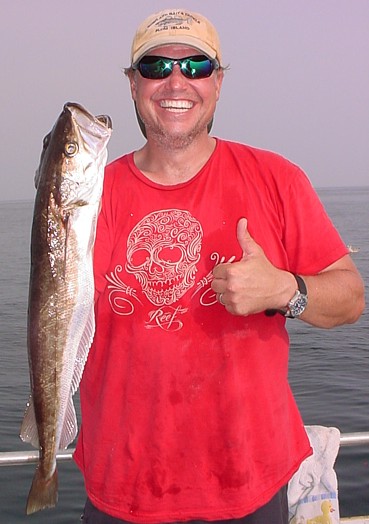 The regulations news had a deleterious effect on the New England Party/Charter fleet. The Clipper Fleet out of Newburyport, Massachusetts (established in 1976) owned by Joe Grady, a good friend of mine over the years and some of the best party boats in New England, decided to terminate his business. I would see Joe on his sixty foot boat, the Challenger, on my forays fishing the Bunny Clark on the southern part of our range when chasing haddock in the spring. He was one of the best at catching haddock. His brother, Tom, also a friend, ran the fifty-five foot Sundance II, also part of the fleet. Gone. Captain Bill's Charters with Captain Bill Wagner, a friend and contemporary, also decided to close up shop. I would often see Bill's boat, the forty-five foot Lady Patricia, on the fishing grounds near us at times. He also sold his smaller boat, the Tyfany Maria. In general, the concerns of those who stayed in the business centered around the number of profitable trips that would be lost for the upcoming season. And, as it turned out, these thoughts were not unfounded.
The regulations news had a deleterious effect on the New England Party/Charter fleet. The Clipper Fleet out of Newburyport, Massachusetts (established in 1976) owned by Joe Grady, a good friend of mine over the years and some of the best party boats in New England, decided to terminate his business. I would see Joe on his sixty foot boat, the Challenger, on my forays fishing the Bunny Clark on the southern part of our range when chasing haddock in the spring. He was one of the best at catching haddock. His brother, Tom, also a friend, ran the fifty-five foot Sundance II, also part of the fleet. Gone. Captain Bill's Charters with Captain Bill Wagner, a friend and contemporary, also decided to close up shop. I would often see Bill's boat, the forty-five foot Lady Patricia, on the fishing grounds near us at times. He also sold his smaller boat, the Tyfany Maria. In general, the concerns of those who stayed in the business centered around the number of profitable trips that would be lost for the upcoming season. And, as it turned out, these thoughts were not unfounded.
[The picture on the left is a shot of Jeff Gellatly (ME) holding his 4.5 pound Maine state trophy whiting (silver hake) in early September, a marathon trip. This was our second largest whiting of the season and fifth all time for the Bunny Clark. The whiting is a delicious fish to eat. When I was growing up, fish sticks were made from whiting exclusively. That was when the fish stick was a very tasty thing to eat. They make them out of pollock now. The pollock probably lends itself to a wide variety of recipes but it is a bland fish as compared to the whiting.]
So I was, at best, ambivalent of our success well before the start of the upcoming 2015 fishing season. But I have many reasons for staying in the business. First, I love the business. I grew up as the son of a commercial fisherman. I fished commercially for many years. To me, the groundfish party boat fishing combined the best of both worlds, the challenge of finding and catching the fish along with people who, in most cases, appreciated it the most. Second, I think we owe it to the people of New England, who might otherwise not have the opportunity, to provide a platform to enjoy our natural resources from an angling perspective. I want the common man to enjoy the catching and eating of the deep sea fish we have in our waters. And I truly believe that we should always have this opportunity. Third, I would hate to think that my son would lose the chance to run a party boat fishing business if he wanted that option. After all, he grew up fishing on the Bunny Clark. Lastly, I would rather fight than give in to something I thought was destructive for all the wrong reasons. And by staying in the fishery I would also be given the voice to fight for what I think is right.
Some of what I expected to happen during the season did happen. We lost about twenty-five percent of the gross sales I believe we would have otherwise been able to capture had the new regulations not been promulgated. The good news was that it turned out to be a wonderful season. We may not have carried as many anglers as we normally do. But because of this we had more room on the boat, were able to provide more individual attention to our anglers and our less experienced anglers saw few tangles. The weather gave us some of the calmest oceans we have seen for many years. We had very little rain as compared to other years. And the catch rate per person could hardly have been much better. It was a wonderful season.
We started taking anglers on May 1, 2015. In so doing, we avoided a few of the bad weather days we typically see in April. The pollock were just starting to show up on the fishing grounds at that time. Normally, they show up earlier. But the winter of 2014/2015 was one of the coldest and snowiest winters I can remember. In fact, it was the coldest in over thirty years! When winters are cold & snowy, I have found that we don't see the pollock or haddock as early as we normally would with a milder winter. On our first trip we found plenty of pollock and haddock. Albeit, the legal pollock were smaller in the first couple of weeks. But, there again, we expected this.
The pollock fishing, overall, was our best for one good reason; we found them mostly in the shallowest of waters. Normally, this isn't the case. The bigger legal fish are usually found off the edge, in the deeper water, on the hard peaks and sometimes on the move. The smaller sub-legal pollock are found on top in the shallowest of waters. Last season, we found the sub-legal pollock where they normally are and in greater numbers than the last few years. However, for most of the season, the larger pollock were also found where the smaller pollock are found. There was never much mixing; either you found the small pollock or you found the bigger pollock. But our three largest pollock of the season, all Maine state trophies, were caught in the shallower water.
The 2015 season was our second best season for total numbers of haddock caught (both legal and sub-legal - I have counted every haddock caught since the early 1980's). Still well above every other year, we were 1,639 haddock shy of the 2014 season. There were two reasons for this. The Federal no haddock possession limit went into effect from March 1 until April 30, 2015 (Wave 2). Every other year we fished in April for haddock, the best month of the year to catch haddock and the best month of the season to land our biggest haddock. Instead, we started the season almost a month later by taking our first trip on May 1, 2015. Once September rolled around, we lost the ability to keep haddock again until November 1, 2015 (Wave 5). This compared to the previous season when the Wave 5 no possession limit for haddock first went into effect. We could have made up for the haddock short-fall last season had we been able to keep them in April. Second, we didn't take as many trips. Plus, we took less anglers per trip. Had we matched last year in regulations, anglers and trips, there is no doubt in my mind that we would have seen a Bunny Clark record year for numbers of haddock caught.
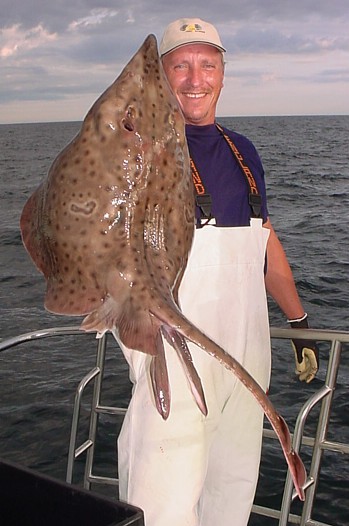 As mentioned, we were prohibited from landing cod in 2015. This doesn't mean we couldn't catch them. But it did mean, for us, that cod would no longer be a target species. Still, we kept track of all the cod of legal size that we would have kept but, instead, had to release. We released half as many of these "legal" cod as we kept the season before, our worst year for cod landings, by far, of any season before it. The cod catch was down for a number of reasons. First, there are not as many cod as there were in the past. Second, we are seeing no signs of recruitment into the recreational fishery as we have seen in previous years. And, third, since we were not targeting cod, we weren't fishing in the areas where we would have caught more cod had we been looking for them. These were the three main reasons, I believe, why we didn't release as many of the legal sized cod as we have landed before 2015. There remains less cod on the fishing grounds than we would see in a healthy fishery in general. And the number of larger spawning individuals has dwindled to the point of extinction, from a visual/practical angling standpoint. I would love to think that the spawning biomass has moved to some other area or region. But I have nothing to make me think that this is the case. I don't believe that the angler is the cause of the problem. But I do believe the angler can help with the problem by staying away from the cod over twenty-eight inches.
As mentioned, we were prohibited from landing cod in 2015. This doesn't mean we couldn't catch them. But it did mean, for us, that cod would no longer be a target species. Still, we kept track of all the cod of legal size that we would have kept but, instead, had to release. We released half as many of these "legal" cod as we kept the season before, our worst year for cod landings, by far, of any season before it. The cod catch was down for a number of reasons. First, there are not as many cod as there were in the past. Second, we are seeing no signs of recruitment into the recreational fishery as we have seen in previous years. And, third, since we were not targeting cod, we weren't fishing in the areas where we would have caught more cod had we been looking for them. These were the three main reasons, I believe, why we didn't release as many of the legal sized cod as we have landed before 2015. There remains less cod on the fishing grounds than we would see in a healthy fishery in general. And the number of larger spawning individuals has dwindled to the point of extinction, from a visual/practical angling standpoint. I would love to think that the spawning biomass has moved to some other area or region. But I have nothing to make me think that this is the case. I don't believe that the angler is the cause of the problem. But I do believe the angler can help with the problem by staying away from the cod over twenty-eight inches.
[The picture on the right is a shot of Steve Selmer (NH) holding his 20 pound barndoor skate, our tenth largest last season, just before releasing it back to the ocean alive. Steve caught this fish on the August 27, 2015 marathon trip in 80 fathoms of water drifting off an edge into deeper water after starting at a shallower edge. The barndoor skate is a fascinating animal to me. We caught them in water depths from 27 to 110 fathoms.]
One of the most fascinating things I will always remember about last year was the number of barndoor skates that were caught on the Bunny Clark. We caught fifteen of them during the 2015 fishing season, a record by far for numbers caught in a single season. All were caught within the Western Gulf of Maine (WGOM) closed area - from 25 fathoms of water to 111 fathoms. I had never seen one caught with rod & reel before 2008. And most of us in the fishery thought they were extinct. I was a kid when I saw the last one. It was caught on a dragger. Rick Gelaznik (MA) was the angler who caught the first one on Bunny Clark. In fact, I didn't see it. It was caught on Saturday, October 4, 2008 during the Onota Fishing Club full day trip charter run by Captain Ian Keniston with deck hand, Jared Keniston. I was ashore working at Barnacle Billy's restaurant. Since that time we have caught one in 2009, none during the 2010 season, one in 2011, two in 2012, one in 2013 and two in 2014. So, before last year, we had caught eight barndoor skates total in the history of the Bunny Clark/Mary E, a span of thirty-eight years. Last years total almost doubled that count! How can anyone think that the closed commercial fishing areas are not working? I truly believe that it just takes more time than what people, regulators and most scientists realize.
In 1994, the World Conservation Union (IUCN) listed the barndoor skate as "vulnerable" under it's "Categories & Criteria". The barndoor skate (Dipturus laevis) became listed as an endangered species in 2003 by the IUCN) and remains so today. This species of fish is only found in the western north Atlantic ocean (New England & Maritime Canada). And it is the largest skate found there, in our region. It is the eleventh largest skate found in the world. Specimens of over 60 pounds and larger have been caught on trawlers (draggers). The common or blue skate (Dipturus batis) is the largest skate in the world attaining weights up to 220 pounds. This skate is found in the eastern north Atlantic off the coast of Europe, the Brittish Isles and the Mediterranian sea. It is listed as critically endangered by the IUCN. Very few of these skates are seen anymore. At one time this skate was highly prized by anglers in the UK. The big skate (Raja binoculata) is the largest skate caught in North America attaining weights up to 200 pounds. It is found in the eastern north Pacific from Alaska to California. Since the fishery is much younger than all the other fisheries in the world and the range of this skate is much larger, this species is still available. The ICUN has listed this species as near threatened. A directed fishery was started in the eastern north Pacific in 2003. Since then the population has dwindled considerably. All three of these skates share the same morphological characteristics, have the same behavioral characteristics, display the same eating habits and are vulnerable to exploitation (dragging/trawling) due to their very slow growth rate, late maturity (8 years for the barndoor), low fecundity, ease of catch by the trawling method and large body size. My point is that the recent increased catch rate within the closed areas should be recognized. Although it's early, this could be another fishery management success story, the reasons for which seem very clear to me. To date there is no management or regulatory measure in place in New England for the barndoor skate apart from ad hoc protection in the closed areas in the Gulf of Maine and the closed areas of Georges Bank.
Another point of interest suggesting the success of the closed areas was the number of whiting (silver hake) that were landed on the Bunny Clark last season. Some of the largest whiting we have ever seen were caught this year along with an increase in numbers landed. We were just shy of an angling world record in one case. More importantly, we caught so many good sized whiting that we added the species to the trophy list for the first time since I first starting writing the Guestletter in 1983/1984. Normally we might give a larger whiting an honorable mention every other year or so. We caught these whiting almost exclusively in the WGOM closed area. As a species they are very good eating. And they are an interesting fish to see. We did not target whiting; all the whiting landings were incidental landings while we were targeting pollock and haddock. I can't imagine what we would have caught had we been interested in them as a target species.
Speaking of honorable mentions, our monkfish count was also up, the most small monkfish we have ever caught on the Bunny Clark. Again, pointing to the success of restricted commercial fishing zones, all our monkfish were caught in the WGOM closed area. We didn't see any large monkfish; indeed, our largest weighed 16 pounds while most were too small to weigh. But seeing many is a good thing for the future of the species. Catching them also promotes angler interest.
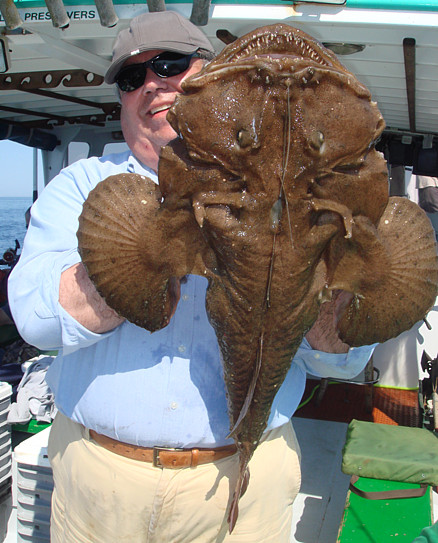 Our hake count was down again this year. For the last three years commercial vessels have been targeting hake to add to their total catch. I can't blame them. I would too if I were still commercial fishing. This is one reason for the Bunny Clark's decrease in hake landings. A bigger reason was that we didn't take as many long offshore trips in the fall as we have in the past. Those long offshore trips were focused on cod landings, a species we were prohibited to keep in 2015. Since those offshore trips also produced some of our biggest pollock and our best pollock catches, it was a good idea to go for cod on those longer trips as you could always fall back on the pollock if needed. And we always worked over the deep gravel edges for white hake to give the trip an added punch or to get a bigger fish. We had plenty of pollock much closer to shore this year. So we really didn't need to go off shore. We did run into a few white hake near shore but didn't see as many as in previous seasons.
Our hake count was down again this year. For the last three years commercial vessels have been targeting hake to add to their total catch. I can't blame them. I would too if I were still commercial fishing. This is one reason for the Bunny Clark's decrease in hake landings. A bigger reason was that we didn't take as many long offshore trips in the fall as we have in the past. Those long offshore trips were focused on cod landings, a species we were prohibited to keep in 2015. Since those offshore trips also produced some of our biggest pollock and our best pollock catches, it was a good idea to go for cod on those longer trips as you could always fall back on the pollock if needed. And we always worked over the deep gravel edges for white hake to give the trip an added punch or to get a bigger fish. We had plenty of pollock much closer to shore this year. So we really didn't need to go off shore. We did run into a few white hake near shore but didn't see as many as in previous seasons.
[The fish on the left is a 16 pound monkfish caught by the angler, Mike Barrows (PA), holding it for the camera. The monkfish is a type of angler fish that sets on the bottom dangling a false bait in front of it's mouth on an evolutionarily developed fin ray in order to lure in "unsuspecting" prey. When the prey gets close enough, a response is elicited where the jaw of the monkfish opens quickly to grab the prey with it's long sharp teeth. The teeth are meant to hold the "food" only until it is moved deeper into the digestive track. The tail is very good eating. Medalions of monkfish was a favorite of Julia Child. (Captain Ian Keniston photo) ]
As for other species, we had variable success.
The major improvement on the Bunny Clark for the 2015 fishing season was the installation of the new engine. I purchased the TAMD D13-700 Volvo diesel engine through Power Products in Wakefield, Massachusetts in early January but it didn't arrive until very early March. So it was a scamble by David Pease and company (Ian Keniston and Jared Keniston) to get the engine installed. They had already spent January & February preparing and painting the engine room when arrival day came. But there was still plenty to do to get ready for it. The engine's mounting footprint was very different from the previous engine. The exhaust system was on the opposite side of the engine. The transmission was smaller. Etc, etc. In the process the shaft had to be changed out and replaced as did the propeller, the cutlass bearing, the shaft seal system, the exhaust tubing and the fuel lines. It was quite a job. Not only was the installation completed on time, it was the best installation I have ever seen. In fact, I can't imagine that it could have been done any better. You could certainly see that Dave Pease was involved in the whole process! I have so much respect for that guy.
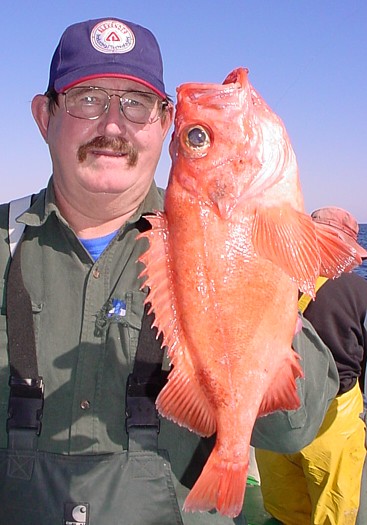 The advantages of the new engine were many. The installation made it much easier to work on the engine including plenty of space to walk around the front of the engine. For instance, changing engine belts and hauler belts was so much easier to complete. The engine produces the same horse power as the previous engine but the new engine was 1200 pounds lighter. This and the fact that the previous engine was too far forward meant that the boat trimmed on it's lines as it should, the boat was lighter (and exactly the same weight as when the Bunny Clark was stability tested with the original engine) and faster. The engine is also a Tier 3 engine. This means that the exhaust emissions are negligible. For the angling patrons of the Bunny Clark, this meant that the engine was quieter, there was hardly any (indeed, no) exhaust smell, the cruising speed was, on average, two knots faster and the boat was noticeably more comfortable while drifting or cruising in heavy weather. We also burned 10% less fuel per hour, the anchor hauling system was much improved, the engine room could be kept much cleaner and engine maintenance systems were much improved making it more efficient to change filters, oil and zinc anodes. Needless to say, I was very pleased all the way around.
The advantages of the new engine were many. The installation made it much easier to work on the engine including plenty of space to walk around the front of the engine. For instance, changing engine belts and hauler belts was so much easier to complete. The engine produces the same horse power as the previous engine but the new engine was 1200 pounds lighter. This and the fact that the previous engine was too far forward meant that the boat trimmed on it's lines as it should, the boat was lighter (and exactly the same weight as when the Bunny Clark was stability tested with the original engine) and faster. The engine is also a Tier 3 engine. This means that the exhaust emissions are negligible. For the angling patrons of the Bunny Clark, this meant that the engine was quieter, there was hardly any (indeed, no) exhaust smell, the cruising speed was, on average, two knots faster and the boat was noticeably more comfortable while drifting or cruising in heavy weather. We also burned 10% less fuel per hour, the anchor hauling system was much improved, the engine room could be kept much cleaner and engine maintenance systems were much improved making it more efficient to change filters, oil and zinc anodes. Needless to say, I was very pleased all the way around.
[The picture on the right is a shot of Larry Kabat (NH) holding his 2 pound Maine state trophy redfish during an offshore marathon trip charter in September 2015. Larry not only has a penchant for catching trophy redfish, he also is one of the most photogenic anglers when it concerns the redfish. Don't ask me why. But it does seem to work out that way. ) ]
The only question I have is the engine longevity. It's a Volvo. That's a plus as far as I am concerned. I have had five other Volvo engines and never had but minor problems with them. But this new Tier 3 engine is all computerized. There are three computer systems that "talk" back and forth to "each other". This means that there are three computer chips with all the wires that go back and forth between them. It seems to me so unnatural that a computer system would work long time in a salt water based environment. But this is the way of the future of engines. And, so I have read, Volvo is way ahead of the pack with these systems. Still, I just can't wrap my head around it. Time will certainly tell.
Having said this, we had far less problems with the "breaking in" period of the engine as opposed to every other new engine I have ever had. And I have had ten since 1972. We had a minor oil suction problem with the oil pump associated with changing the oil. The oil suction hose was installed on the wrong side of the engine. All we had to do was take it off one side and put it on the same side as the oil filters. This was actually better because fittings inspection was in the same place I would be while changing the oil. We had a recall notice from Volvo addressing the pulley assembly on the front of the engine. That was an easy fix and it didn't cost me anything or create any down time. Also, a couple of the roller bearings had to be changed out including the tensioning point. This was also on warranty and didn't create down time. There were a couple of electronic glitches with the engine's computer system. But these were solved with a phone call and was just part of the learning process. All in all it was the most favorable engine year I can ever remember. I am, of course, getting older and the memory is not as it was!
Other improvements with the Bunny Clark were structural and cosmetic. These repairs/improvements were of no noticeable difference to our angling patrons.
We made one improvement on the fishing gear side of things last season. Working with John & Elsa Tenczar at Fish-On Tackle, John came up with a single hook 16 ounce jig that we saw much success with. I have been concerned over the years that the treble hook on our most popular jig, the Lavjig, was killing fish unnecessarily. Of most concern to me was the "gaffing" of sub-legal cod in the side while using it. Most of these cod were disemboweled in the process. John's model eliminated that. The single hook he came up with had a heavy enough wire gauge with the hook tip pulled slightly inward. So if you hooked a fish, it was 99.9% right in the mouth, there was no thought that the hook would bend and was plenty sharp enough for good penetration. Also, the hook provided a platform where you could slide one of the soft plastic "smart baits" on the hook. We used Mojo's black/gold flake "mullet" swim baits. And I have to tell you, we got better results than I ever expected. One of the best results was the landing of most of our biggest pollock in the fall. In fact, yours truly caught two pollock of 22 pounds each with very little fishing time on a trip that hosted less than a normal count of anglers. Those were the two biggest fish of the trip that day; no one else was using that jig style. I didn't introduce the jig until late in the fall as there was quite a bit of back-and-forth with John before I was satisfied with the hook selection. And, for that reason, we didn't have the whole year to evaluate a total performance package. But for that short a period of time (part of September and all of October), the jig was everything that I had hoped it would be; the jig's selectivity was very good and the incidental killing of unwanted fish was next to zero! These jigs will be available at the start of the 2016 Bunny Clark fishing season. I buy most of my jigs from Fish-On Tackle. John can be reached at johnfishon@comcast.net.
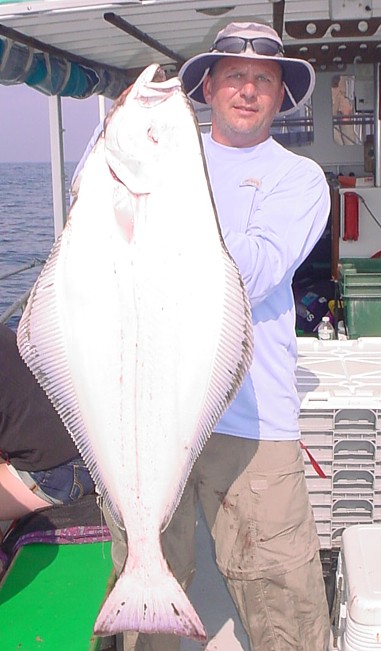 As usual, two of the places I rely on most are Surfland Bait & Tackle, Newbury, Massachusetts (Kay Moulton, proprietor) and the Saco Bay Tackle Company in Saco, Maine. Kay is the last word when it comes to terminal gear, swivels, bait hooks, reel repair questions and rod building questions as it pertains to salt water fishing in New England. I buy all my swivels and bait hooks from Kay. I have very much enjoyed doing business with her since the early 1970's. Both of these places have been responsible for building excellent rods to my specifications. Saco Bay Tackle Company specifically builds a deep water jigging rod that is second to none with the Bunny Clark logo and my explicit stamp of approval. I also buy specialized line from them. Both businesses are top notch tackle stores, the best.
As usual, two of the places I rely on most are Surfland Bait & Tackle, Newbury, Massachusetts (Kay Moulton, proprietor) and the Saco Bay Tackle Company in Saco, Maine. Kay is the last word when it comes to terminal gear, swivels, bait hooks, reel repair questions and rod building questions as it pertains to salt water fishing in New England. I buy all my swivels and bait hooks from Kay. I have very much enjoyed doing business with her since the early 1970's. Both of these places have been responsible for building excellent rods to my specifications. Saco Bay Tackle Company specifically builds a deep water jigging rod that is second to none with the Bunny Clark logo and my explicit stamp of approval. I also buy specialized line from them. Both businesses are top notch tackle stores, the best.
Our web site at http://www.bunnyclark.com continues to be the location where you can get information about the Bunny Clark operation on a daily basis during the season and off-season. We have a schedule and rates section, a photo section, a world records section and more. Our fishing update section provides anglers with up to date information on the daily catch, fish sizes, daily weather, angler deeds and fishery management information. This Guestletter resides on our web site along with some of my previous Guestletters. Although I canít personally answer all the email that comes in associated with the site, our staff does a great job with this while also answering reservation questions and scheduling fishing dates. We are still not planning to use the email as a direct source of making reservations as the phone serves as a better means to take care of anyone on an equal basis.
[Our biggest halibut last season, a legal one, was a 37 pounder caught by John Andreychak (NJ) on a full day trip at the end of July. The picture on the left shows him holding the fish with the underside of the fish to view. My preference is a view of the top. But this view is in stark contrast to the opposite view and does pose a unique perspective. This is the only Atlantic halibut that John has ever caught. The oddest thing about it is that I had told one of my customers on the way out that the weather was perfect for catching a halibut and that the first spot was chosen for that reason. We caught quite a few halibut over the years in the same small area. And yet, John didn't hook this fish in the mouth. It was snagged in the side! ]
This is the fourth season that I haven't worked on my groundfish tagging program. This was in partly due to a decrease in the cod population, our primary target fish, partly due to the fact that we couldn't keep cod this season and partly because, to target cod, I would have to leave the fish we were allowed to keep. So, all in all, without cod in the picture, the tagging program would be less meaningful. Added to this, we have so much more we are required to do, making the addition of a tagging program an activity that took us away from fully servicing our passengers.
We maintain a healthy Maine state trophy program to recognize larger than normal fish. This year we had one potential world record. Jason Collier (VT) was the man. He came closest to the whiting world record when he boated a 5 pounder (silver hake - Merluccius bilinearis) on August 26th. The last time we landed a whiting that large was on August 8, 1995. The whiting then was slightly larger, initial weight, caught by Erik Callahan on the Bunny Clark. Erik's whiting became the IGFA All-Tackle World Record with a registered on-shore weight of 4 pounds 8 ounces. Erik's record is still current today. In order for Jason to have beaten this world record his whiting would have had to have been larger by 2 ounces after getting it ashore and weighing it on a registered scale. I use the U. S. Postal Service in town. Their scales are officially registered every day. Since Jason's fish was not as large as Erik's initially, the weight loss would have dropped it below the value already established. In the last eight years we have been close on the whiting and white hake All Tackle World Record, never close enough to go through the motions. We also caught the largest barndoor skates last season I have ever officially seen. At this time, the barndoor skate is not accepted as a viable world record species. This is probably because of it's endangered species status. I will talk more about size relationships below with the accompanied trophy list. You may enjoy checking out all of our current and past world and state records by accessing the records link at http://www.bunnyclark.com or by going directly to http://www.bunnyclark.com/records.htm.
As mentioned above, the Federal recreational fishing regulations were different and more restrictive during the 2015 season than they were in 2014. For starters, there was no possession of cod after having a bag limit of nine cod per angler in 2014. The outcome of this regulation alone dropped gross sales twenty-five percent from 2014. Many of my regular anglers just didn't believe it was cost effective for them to buy a ticket and not be able to keep cod. Second, our haddock regulations changed from having an unlimited bag limit with a minimum size of twenty-one inches and no retention of haddock during Wave 2 (March & April) and Wave 5 (September & October) to a three haddock bag limit with a minimum size of seventeen inches and the same possession prohibition in Wave 2 and Wave 5. Because of these regulations we didn't start taking passengers until May 1, 2015, a month late. We had very minimal reservation calls for anglers desiring a fishing trip before that date. In the past, where September and October were very popular as a time to go fishing, attendance dropped dramatically. Even more so in 2015. I believe that there were some anglers who were surprised when they showed up for a trip on the boat in Wave 5 during the 2014 season. When Wave 5 struck again in 2015, the no retention limit for haddock during those months was well known. And it showed in angler participation percentages. No doubt, some anglers did not want to be disappointed by catching nice haddock and having to release them. I myself wasn't really disappointed in this. I had expected it. And I was encouraged by the number of anglers who did participate in 2015. My perspective on the regulations is that if the recreational angler needs to be part of the conservation process then give them regulations that make sense and stay with those regulations for a good number of years. This way we can rebuild and grow our party/charter businesses around new stable regulations. When these different Federal organizations keep changing the regulations every year, anglers have no idea what is going to happen next. And it makes it very difficult indeed to plan future fishing trips when you don't know what you will be fishing for in the future. This is relevant for both the patron and the business owner.
The recreational angler regulations will be much less restrictive in 2016, I am very happy to say! On May 1, 2016, anglers will be able to enjoy a bag limit of fifteen (15) haddock per person and a minimum size limit of seventeen (17) inches with no additional haddock restrictions through the rest of the 2016 fishing season. That means that we be able to enjoy the fifteen haddock bag limit through September & October, unlike last season. At the present time, there is also the thought that the NMFS will relax the haddock restrictions during April 2016. At the present time this has not been confirmed. Nor, has there been a proposed new regulation for haddock during that month. We might also be able to keep a cod a person with a minimum size limit of twenty-four inches during the months of August & September. There will be a no possession limit on cod before and after those months. We will not be limited in the areas we can fish except for the Whaleback Spawning Closure to the south and east of the Isles of Shoals. As in 2014: There will be a 12 inch minimum size on winter (blackback) flounder, a 19 inch limit on pollock (with no bag limit), a 9 inch limit on redfish (with no bag limit) and a 41 inch limit on halibut (same as 2014). Halibut landings are limited to one halibut per vessel per day Federally; state wise we are limited to five halibut per calendar year (Maine only). There is no size limit or bag limit on hake (both white, red & silver hake), mackerel and cusk. There is a minimum size of 54 inches (caliper fork length) for possessing mako sharks, porbeagle (mackerel) sharks & thresher sharks. You will be able to land a bluefin or two or three or four (per vessel) of an undetermined size (to be established at the beginning of the season on June 1, 2015). It is illegal to keep barndoor skates, eel pouts and wolffish.
The start date of April 14, 2016 has been determined as the date of our first fishing trip of the season, a marathon trip where I will be the captain and Captain Ian Keniston will be the deck hand. Jared Keniston could also be working that day. Sometimes Jared goes the first day, sometimes he doesn't. I have selected that date regardless of whether we will be able to keep haddock or not because we are having a mild winter. When that happens and the ocean water is warmer than expected, the pollock show up early as well. If so, the middle of April should be the time when we see our first good sized pollock and haddock on the fishing grounds. We shall see how the winter progresses.
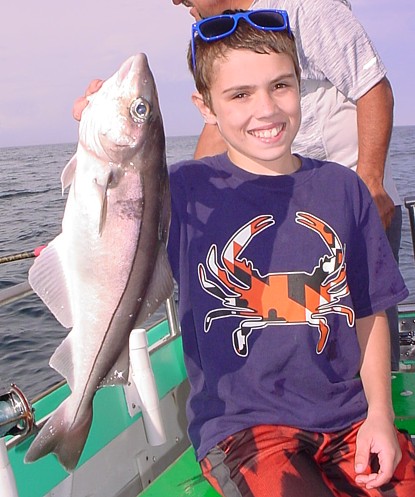 The Conservation Law Foundation (CLF) came out with a short video in August 2014 about keeping the status quo on the Cashes Ledge closed area. I had a brief part in the video. I am very supportive of keeping the Cashes Ledge area closed and keeping the status quo on the Georges Bank closed areas numbers 1 & 2 as well. Some on the New England Fishery Management Council (NEFMC) want to see Georges Bank, particularly, opened to dragging. This is where our haddock are coming from or came from initially, the biggest groundfish success story of the NEFMC. In 2015, the Council voted to keep the Cashes Ledge area closed. But they also voted to rearrange the closed areas on Georges Bank and to open up the eastern edge of the Western Gulf of Maine (WGOM) closed (Jeffrey's Ledge) area. The vote to open the eastern WGOM passed by only one vote. I was disappointed in the recommendations from the Council. Now it is up to NOAA (NMFS) to determine if there is merit in the Council's recommendations to open up the closed areas to commercial fishing or to maintain the status quo. Or a little of both. I am totally in favor of the status quo for reasons I will not go into in this Guestletter
The Conservation Law Foundation (CLF) came out with a short video in August 2014 about keeping the status quo on the Cashes Ledge closed area. I had a brief part in the video. I am very supportive of keeping the Cashes Ledge area closed and keeping the status quo on the Georges Bank closed areas numbers 1 & 2 as well. Some on the New England Fishery Management Council (NEFMC) want to see Georges Bank, particularly, opened to dragging. This is where our haddock are coming from or came from initially, the biggest groundfish success story of the NEFMC. In 2015, the Council voted to keep the Cashes Ledge area closed. But they also voted to rearrange the closed areas on Georges Bank and to open up the eastern edge of the Western Gulf of Maine (WGOM) closed (Jeffrey's Ledge) area. The vote to open the eastern WGOM passed by only one vote. I was disappointed in the recommendations from the Council. Now it is up to NOAA (NMFS) to determine if there is merit in the Council's recommendations to open up the closed areas to commercial fishing or to maintain the status quo. Or a little of both. I am totally in favor of the status quo for reasons I will not go into in this Guestletter
[I took this picture during the afternoon half day trip of August 4, 2015. It shows eleven year old Vinnie Congialdi (PA) holding the biggest of two legal haddock he caught during the trip. This haddock weighed 4 pounds, the largest haddock of the trip and the largest haddock that had been caught during an afternoon trip at that time. That evening, Vinnie also caught a legal pollock. Vinnie wasn't high hook but he was one of three anglers catching the most legal fish on that trip. You could be looking at a picture of the bright future of the Bunny Clark! ]
Since then, the CLF and other conservation groups have tried to go further with the Cashes Ledge closed area and make it a Marine National Monument. Monuments are designated by Presidential Proclamation, via the Antiquities Act of 1906. The Act provides broad power to set aside public areas for protection, and requires no public process. The CLF and associated groups have also included some offshore canyons in the Marine National Monument project. The first presentation to the President was met with ambivalence during 2015. I don't think he or his advisors knew enough about the idea to be for or against this. So they dropped this issue at that time. There is going to be another time when this idea could be seriously considered. Soon. I was all for the Monument idea initially, before the Council vote; I would rather see the Cashes Ledge area closed to everyone rather than open it up for commercial fishing, dragging in particular. Also, any ocean area that becomes a National Monument can never again be governed by the Council. Now that the Cashes Ledge area is going to remain closed for a time, I too am ambivalent about going the Monument route. And here's why; any access to the Cashes Ledge closed area could be denied for research purposes. This means recreational groundfishing, lobstering, mid-water herring trawlers or tuna fishermen would not be allowed inside. I'm not saying that this would happen. But it certainly could. For this reason, almost every fishing organization is against the idea of a Marine National Monument. One thing I am against is allowing mid-water herring trawlers into any of the closed areas. If you want to make an area safe for groundfish, don't take the forage fish that keeps them there. Fishery management has some challenges for the future.
Here are some other future fishery management challenges ahead of us for New England waters as it relates to our groundfish. These are problems that need to be addressed before we can have a healthy sustainable fishery:
These are just a small number of the challenges we face in the New England fishery. But I feel they are most germane to us. I was reluctant at first to put these last seven paragraphs in this Guestletter. But all of this is important to the recreational angler, our Bunny Clark groundfish fishermen. And it serves to educate those who may be less informed about what is happening in the waters around us. It also may give some people knowledge they otherwise might not have if I didn't mention it. And it might bring more anglers into the fishery management process to argue against unfair practices that threaten to undermine the groundfish recovery plan. We need a healthy sustainable fishery for both recreational and commercial fishermen. This will not happen if we just stand by and watch.
As I feel that the greatest achievement in angling is the ability of a person to hook and land a trophy fish on their own, I have listed the guests who caught the top five largest of each significant species during the 2015 fishing season. Keep in mind that all the represented weights of these fish were taken aboard the Bunny Clark using a registered scale shortly after capture (the same way it has been done since our first fishing trip on the Bunny Clark in May 1983). I feel that this is the fairest comparison between the anglerís fish since weight loss is proportional to the amount of time the fish is out of water. This also makes the weight of every fish caught comparable through all the past and present Bunny Clark fishing seasons.
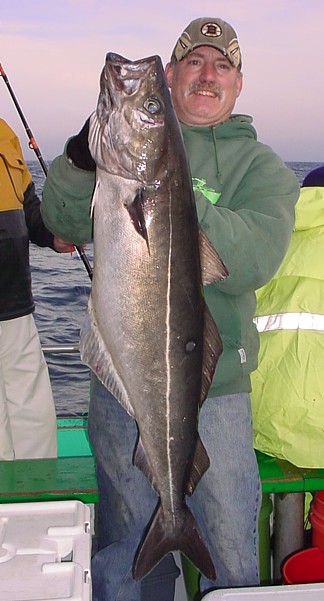
|
NAME (STATE) |
FISH - lbs. |
LENGTH X GIRTH (inches) |
DATE CAUGHT |
|
Mike Barrows (PA) |
Monkfish 16 |
09-16-15 |
|
|
Don Brown (NY) |
Monkfish 11.5 |
09-09-15 |
|
|
Ken Gibson (NY) |
Monkfish 11 |
09-09-15 |
|
|
Paul Pearson (NH) |
Monkfish 9.5 |
10-08-15 |
|
|
Ken McLaughlin (ME) |
Monkfish 9 |
07-27-15 |
|
Wayne Statham (QC) |
Barndoor Skate 33* |
07-20-15 |
|
|
Josh Cabral (RI) |
Barndoor Skate 31* |
08-30-15 |
|
|
Kate Cote (ME) |
Barndoor Skate 26* |
07-27-15 |
|
|
Jim Walls (MD) |
Barndoor Skate 26* |
08-20-15 |
|
|
Larry Lawrence (NY) |
Barndoor Skate 26* |
09-10-15 |
|
Tom Ruggles (FL) |
Redfish 4.0 |
18 X 14 |
08-04-15 |
|
Russ Jarvis (MA/FL) |
Redfish 2.5 |
16.75 X 14 |
06-04-15 |
|
Rob Hathorn (NH) |
Redfish 2.5 |
17.5 X 13 |
09-15-15 |
|
Chris Kirste (ME) |
Redfish 2.3 |
16.25 X 13 |
06-25-15 |
|
Smokey Dorsey (NC) |
Redfish 2.25 |
15.75 X 11.5 |
09-08-15 |
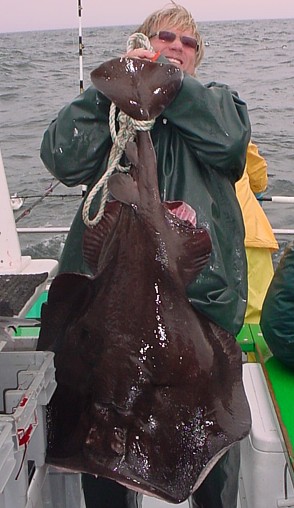
|
Matt Laubauskas (MA) |
Wolffish 16 *** |
06-20-15 |
|
|
Gary Ublacker (NY) |
Wolffish 14 *** |
05-29-15 |
|
|
Sean Spain (NY) |
Wolffish 13.5 *** |
05-29-15 |
|
|
Nigel Jones (Wales, UK) |
Wolffish 13 *** |
05-01-15 |
|
|
Chris Tankred (OH) |
Wolffish 12+ *** |
Released Unintentionally Before Weighing |
05-12-15 |
|
Tom Donaghy (ME) |
Pollock 29 |
42 X 24 |
08-12-15 |
|
Dana Decormier (NH) |
Pollock 27.25 |
41.5 X 22 |
10-22-15 |
|
Mike Kruszyna (ME) |
Pollock 26.5 |
43 X 24 |
09-20-15 |
|
Ryan Holloway (NC) |
Pollock 24.5 |
09-22-15 |
|
|
Steve Giuffre (CO) |
Pollock 24 |
08-14-15 |
|
|
Jason Rochette (VT) |
Pollock 24 |
09-01-15 |
|
|
Mike D'Angelico (NY) |
Pollock 24 |
09-16-15 |
|
|
Cliff Kruger (MA) |
Pollock 24 |
11-02-15 |
|
Steve LaPlante (CT) |
White Hake 44 |
48.5 X 33 |
07-07-15 |
|
Adam Towle (NH) |
White Hake 40.5 |
48.5 X 31 |
07-07-15 |
|
Jon "Griff" Griffin (MA) |
White Hake 37 |
44 X 30 |
07-07-15 |
|
Katie Baumann (MA) |
White Hake 36.25 |
44 X 30 |
07-07-15 |
|
Ray Westermann (MA) |
White Hake 35.25 |
45 X 28 |
07-07-15 |
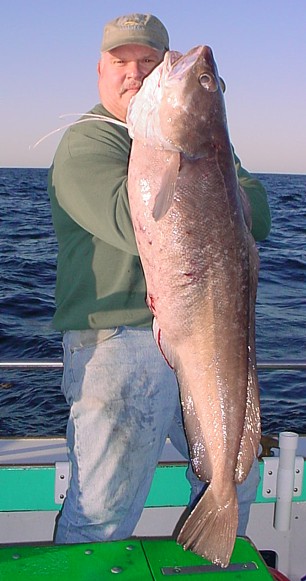
|
Bryan Lewer (FL) |
Haddock 8.25 |
28.5 X 14 |
07-07-15 |
|
Norman Leger (MA) |
Haddock 7.75 |
27 X 15 |
06-18-15 |
|
Sam Readinger (PA) |
Haddock 7.25 |
29 X 14 |
05-05-15 |
|
Russ Jarvis (MA/FL) |
Haddock 7.25 |
? |
06-04-15 |
|
Brien Erwin (VT) |
Haddock 7 |
27.5 X 15 |
05-14-15 |
|
Jon Griffin (MA) |
Haddock 7 |
26.5 X 14.5 |
05-14-15 |
|
Dana Decormier (NH) |
Haddock 7 |
26 X 15 |
06-16-15 |
|
Ron Tarentino (MA) |
Haddock 7 |
26.5 X 14 |
06-18-15 |
|
Mark Coleman (NY) |
Haddock 7 |
? |
09-08-15 |
|
Jason Collier (VT) |
Whiting 5 |
08-26-15 |
|
|
Jeff Gallatly (ME) |
Whiting 4.5 |
24.5 X 11 |
09-03-15 |
|
Jon Griffin (MA) |
Whiting 3 |
23 X 9.5 |
10-22-15 |
|
Dennis Pine (PA) |
Whiting 2.5 |
09-10-15 |
|
|
Steve Stanvick (ME) |
Whiting 2.5 |
09-22-15 |
|
|
Craig Belongie (MA) |
Whiting 2.5 |
09-22-15 |
|
|
Chuck Lennon (MA) |
Whiting 2.5 |
10-08-15 |
|
Buddha Hayes (MA) |
Torpedo Ray 60 |
Released Alive |
10-22-15 |
|
Bruce Fortier (NH) |
Lobster 2.5 ** |
08-27-15 |
|
|
Jim "Chip" Chiaponni (CT) |
Lobster 2 ** |
07-20-15 |
|
|
Tim Tower (ME) |
Lobster 2 ** |
09-03-15 |
|
Paul Smegal (MA) |
Cusk 26.25 |
39 X 25 |
07-07-15 |
|
Katie Baumann (MA) |
Cusk 21.25 |
37.25 X 23 |
07-07-15 |
|
Steve LaPlante (CT) |
Cusk 18 |
35.75 X 22 |
07-07-15 |
|
Dennis Pine (PA) |
Cusk 17.25 |
36.75 X 20 |
09-10-15 |
|
Brian Walsh (NJ) |
Cusk 15.75 |
33 X 20 |
08-04-15 |
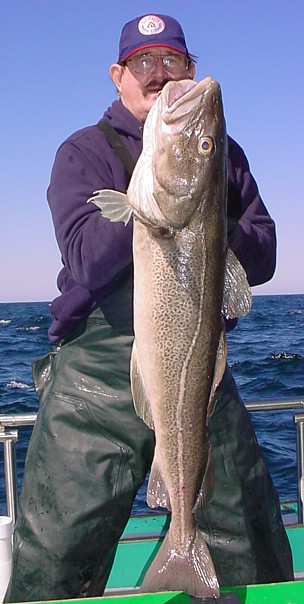
|
Larry Kabat (NH) |
Cod 25.5 *** |
09-15-15 |
|
|
Ed Voss (NY) |
Cod 18.5 *** |
06-07-15 |
|
|
Dick Lyle (PA) |
Cod 18.5 *** |
06-24-15 |
|
|
Fred Kunz (NH) |
Cod 18 *** |
07-14-15 |
|
|
Ryan Lavigne (NY) |
Cod 17.5 *** |
06-10-15 |
|
|
Gene Jablonski (NY) |
Cod 17.5 *** |
06-19-15 |
|
John Andreychak (NJ) |
Halibut 37 |
46 |
07-28-15 |
|
Ron Alpine (MA) |
Halibut 25 ** |
38 |
07-29-15 |
|
Jeff Corey (MA) |
Halibut 22.5 ** |
36 |
08-14-15 |
|
Lane Winney (NY) |
Halibut 22 ** |
36 |
08-10-15 |
|
Mike Harr (OH) |
Halibut 20 ** |
08-03-15 |
|
Dick Slocum (NJ) |
Porbeagle Shark 304 |
92 X 47 |
05-17-15 |
|
Ray Westermann (MA) |
Porbeagle Shark 53 ** |
45 |
10-21-15 |
|
Herb Lee (NY) |
Porbeagle Shark 48 ** |
06-07-15 |
|
|
Henry O'Shaughnessy (MA) |
Porbeagle Shark 29 ** |
10-23-15 |
|
|
George Berne (MA) |
Porbeagle Shark 27 ** |
10-22-15 |
|
|
Joe Columbus (MA) |
Porbeagle Shark 25+ ** |
Released Unintentionally Before Weighing |
10-12-15 |
Where there is a tie in fish size, anglers are arranged in order of the date caught. Earlier catches are placed first.
* Barndoor skates are presently on the endangered species list. All the skates listed were released back to the ocean alive after a quick picture of the angler with his/her fish.
** These fish (lobsters) were sub-legal or illegal to keep and released back to the ocean alive.
*** Federal regulation prohibits the retention of wolffish or the retention of cod during the 2015 season. All these fish were released back to the ocean alive.
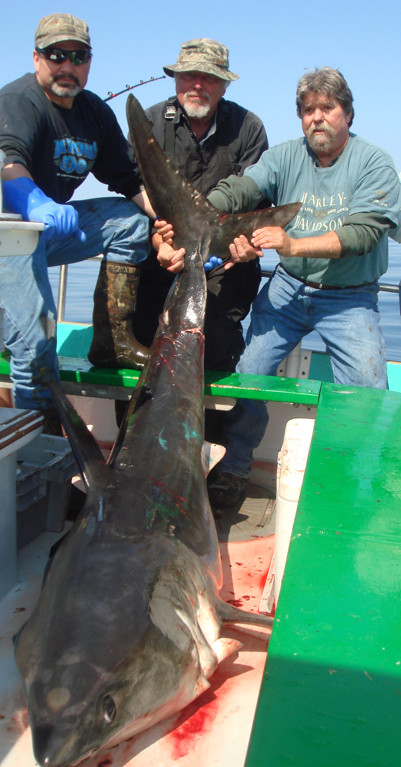
[On the left is a digital image taken by Captain Ian Keniston of the 304 pound porbeagle shark caught by Dick Slocum (NJ). The anglers in the picture include (from left to right) Dean Wolf (NJ), Dick Slocum and Jim LeMay (ME).]
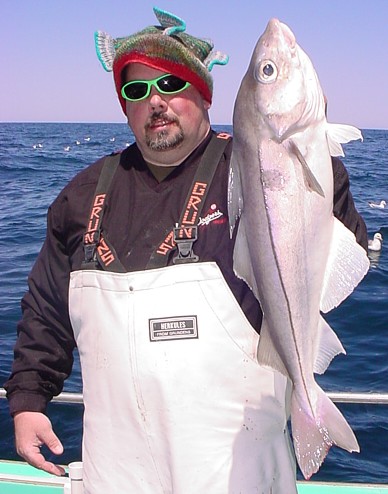
Before I end this Guestletter, I want to cite those anglers and experiences of note that deserve an honorable mention for their uniqueness and/or fishing prowess during the 2015 Bunny Clark fishing season. I realize that this is a value judgment on my part but I believe that my conclusions are recognized as a popular opinion and/or statistical fact among my crew and fishing guests and are based on many fishing trips and many seasons in the business. These special anglers and incidents are as follows:
[The picture on the right is a digital image of FY '15 Jon "Griff" Griffin holding his 7 pound Maine state trophy haddock. Notice the fish hat and the specially selected fishing glasses in Bunny Clark green!]Fisherman of the Year (FY-í15): Jon "Griff" Griffin (MA) won this award for the first time last season. He has been close for many years including fourth place in 2014 and third place in 2013. But never has he done as well, during a season's angler comparison, as last year.
As most of you know by now, the FY award is based on a point system that relates to specific achievements during each trip for a season on the Bunny Clark. Each achievement is worth a set of points. The individual with the most points at the end of the season wins. In order to compete in this category, you have to have paid for and completed at least 10 different trips on the Bunny Clark. I have had many excellent anglers who fish with us on a regular basis every season, any one of whom has the potential to become the Fisherman of the Year. Griff was the man last season. Where Griff excelled was in the trophy department. He had the most trophy fish in the top five, he had the most trophy fish for an angler overall and he was the most consistent angler with trophy landings. Plus, he appeared in last years trophy list for five different species of fish. The point total he attained on trophy achievements far out weighed the points achieved in other categories by any other angler. Griff's attitude is one of the best. He never gets rattled. But he is also excited to go fishing whenever he goes. It is always a great pleasure to have him on the Bunny Clark. I know this sentiment is felt by every one of my crew and most of the passengers. Thank you for making my fishing year just a little bit better, Griff. And congratulations on the most prestigious award we offer at Bunny Clark Deep Sea Fishing! This gives you bragging rights for one full season!
Griff's total point count was 83. Ray Westermann came in second place with a point total of 44. Norm Herrick (ME/MA) was third with 38 points, these points attained without a single trophy fish. That's pretty good. Ken McLaughlin (ME) was fourth with 28 points.
Female Angler of the Year: Katie Baumann (MA) was new to the Bunny Clark last season. If she had been on the boat before I didn't remember it. Katie was, by far, the most successful female angler on the Bunny Clark in fishing year 2015. This is a different award than the FY award. The FAY category doesn't have the intense competition that the Fisherman of the Year award has. This is mainly because we have many fewer regular female anglers. The Fisherman of the Year award is open to any gender. In fact, Linda Paul (ME) won the FY '90 award, attaining so many points that only four other anglers in the Bunny Clark's history have ever garnered more! That year Danny Angerman (MA), one of the best groundfish anglers I have ever known, took the "Male Angler of the Year" award! Some of Katie's achievements last season included the fourth largest hake of the season (see list above), the second largest cusk of the Bunny Clark season (see above - and probably New England) and it didn't hurt that she usually sat beside her dory mate, Jon Griffin, on all her trips. Plus, she caught a lot of fish on every trip she attended. Nice to meet you, Katie. Congratulations from us all!
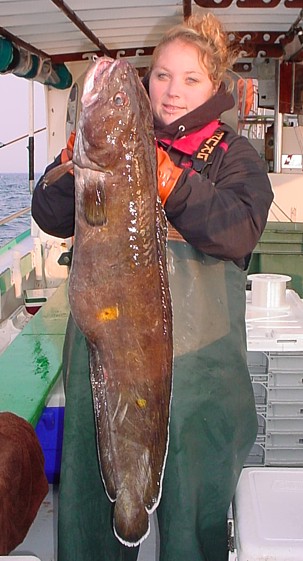 Best Bait Fisherman: Shameless Ray ďThe Pole Tossing Master BaiterĒ Westermann landed this award again last year - as he has for the last eight seasons in a row. He's simply the best at it. And I could not think of anyone who could have taken his place. There were some anglers who were close but certainly not up in Ray's category. Ray was FY '14.
Best Bait Fisherman: Shameless Ray ďThe Pole Tossing Master BaiterĒ Westermann landed this award again last year - as he has for the last eight seasons in a row. He's simply the best at it. And I could not think of anyone who could have taken his place. There were some anglers who were close but certainly not up in Ray's category. Ray was FY '14.
Most Aces: For those who donít know, an angler scores an Ace when he or she lands the three (or more) largest fish during a single trip. There can be no ties in fish size with other anglers in order to achieve true ďAceĒ status. There was only one Ace landed during the 2014 fishing season, six Aces in 2013 and not a single Ace in 2012. The 2012 season was the first season that the Bunny Clark didn't see a single Ace. The 2015 season was the second!
[The shot on the left is a digital image of Katie Baumann holding her 21.25 pound Maine state trophy cusk. Just another example of her fishing prowess!]
Most Trophy Fish (including hake over 15 pounds, cod & pollock over 20 pounds, redfish 2 pounds or more, haddock of 7 pounds or more and the fish seldom caught with rod & reel including monkfish, barndoor skates, whiting, torpedo rays, porbeagle sharks, bluefin tuna, wolffish & halibut) of the Season: Jon Griffin caught the most with a count of nine. Chuck Lennon (MA) and Wobby Barnes (MA) tied for second place with eight trophy fish each. Jeff Gellatly (ME) and Fred Kunz tied for fourth place with six trophy fish each.
Top Five Largest Fish of the Bunny Clark Season: Dick Slocum caught the largest with the 304 pound porbeagle shark. Buddha Hayes came in second with his 60 pound Atlantic torpedo ray. Ray Westermann was third with his 53 pound porbeagle shark. Herb Lee was fourth with his 48 pound porbeagle shark. Steve LaPlante was fifth with his 44 pound white hake.
Most Trophy Fish during a Trip: Chuck Lennon, Wobby Barnes & Jeff Gellatly all tied for the most trophy fish caught during a single trip with a count of six fish each, all on the same day! Steve LaPlante, Dick Lyle, Dan Killay (VT), Steve Selmer (NH) & Jim Jarvis all tied for the fourth place with a count of four trophy fish each.
Most Pools (largest fish of the trip): Jack Judge (ME/CT) & John Russell (ME) tied for the largest fish of the trip four times each! Buddha Hayes, Ken Fowler (PA), Lou Schoenig, Norm Herrick and Wade Smith tied for second place with a count of two pools each. Incidently, Norm Herrick also took second place six different trips! Two of those trips he won the money pool for the largest fish because the angler with the largest fish did not enter the money pool! Better said, Norm was either first or second in fish size on eight trips last season! He didn't sail on that many more trips last season total!
High Hook: Steve Levine (ME) was high hook (the most legal fish on a trip) on eight different trips, the most for an angler during the 2015 Bunny Clark fishing season. Norm Herrick & Jack Judge tied for second place with four counts each. Joe Dressner (NY) & John Russell tied for fourth with three counts each.
Biggest Double: (The most combined weight of two fish caught on the same line at the same time.) Jim Koster (NH) captured the largest double keeper catch of the season in late August. His double included a 20 pound pollock and a 17.5 pound pollock. The second largest double keeper catch last season was one caught by Paul Smegal. As mentioned above, his double included a 26.25 pound Maine state trophy cusk and an 11 pound cusk. The 11 pound cusk was only a pound shy of qualifying for a Maine state trophy! The third largest double keeper catch was caught by Dana Decormier. His catch included a 27.25 pound pollock and a 9 pound pollock. Dan Merrow (NH) came in at number four with a double keeper catch that included a 18 pound pollock and another 18 pound pollock. The fifth largest double keeper catch of the 2015 season was landed by D. J. Crouse (ME). His catch included an 18 pound pollock and a 17.5 pound pollock.
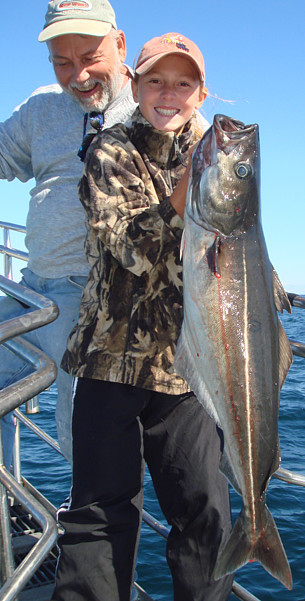 Hardest Luck: The hardest luck of the year has to go Donna Moran (NY). During the middle of July she was on an offshore trip with me enjoying the best groundfishing trip of her life (her words) when she lost her wedding ring over the side never to return! The ring wasn't just some ordinary wedding band either. It was a very elaborate, heavy, hand crafted & designed, very personal and high quality (mostly gold) wedding band. She was heart broken. Donna didn't show it much. She doesn't show that much emotion around the boat anyway. But I could tell that it hurt. I know if anyone ever finds that ring they are either going to think that it belonged to some exotically beautiful, weathy princess from some foreign land or that some sunken treasure ship worth billions is near by! Of course, sentimental value can't be measured. I know. You may well ask.
Hardest Luck: The hardest luck of the year has to go Donna Moran (NY). During the middle of July she was on an offshore trip with me enjoying the best groundfishing trip of her life (her words) when she lost her wedding ring over the side never to return! The ring wasn't just some ordinary wedding band either. It was a very elaborate, heavy, hand crafted & designed, very personal and high quality (mostly gold) wedding band. She was heart broken. Donna didn't show it much. She doesn't show that much emotion around the boat anyway. But I could tell that it hurt. I know if anyone ever finds that ring they are either going to think that it belonged to some exotically beautiful, weathy princess from some foreign land or that some sunken treasure ship worth billions is near by! Of course, sentimental value can't be measured. I know. You may well ask.
Second place has to go to Dave Harris (MA). Dave lost more big fish last year than any angler in recent history. In fact, I don't know of any angler in the past who has lost as many big fish. Any captain or angler would have given his eye just to see some of the fish that he lost! The litany of potential monsters lost included bluefin tuna, big pollock, a halibut or two, maybe a big cod and a porbeagle shark. Now these are assumptions as none of the fish were ever seen. Dave has shown us all in the past that he has what it takes to hook a big fish. He has shown me big doubles and big fish in the past. He's shown me strange fish including our fifth ever barndoor skate in 2012. But, for some reason, last year he just didn't have that little extra it took to get the prize fish to the boat. Most of the fish he broke off the jig, the leader, the fly loop and right in the middle of the line. And, yes, he probably lost the most jigs of any angler last year as well. On August 6, last season, his thirteen year old daughter, Erin Harris, beat him in the boat pool with a 14.5 pound pollock. And that was probably his best trip of the season! The good thing is that he hooked these fish. The even better thing is that he may be back next year. And if so maybe we will at least get a look at one of these big fish!
[The picture on the right is a shot of thirteen year old Erin Harris (MA) holding her pool winning 14.5 pound pollock, the largest pollock of the trip that day. Dave, her father, can be seen behind her. Digital image taken by Captain Ian Keniston.]
I'm not sure if there really was any other hard luck story that deserves a third place in this Guestletter. However, there is one that I would like to mention. This only because the angler aboard has sailed with us for so many years. His name is Bill Bolotin (MA). He was on the Lighthouse Fishing Club marathon trip charter hosted by Captain Ian Keniston in late September last season. On that trip, Jay Kay (MA) had the pool leading fish, a 26.5 pound pollock that went on to be the Bunny Clark's third largest pollock of the fishing season. Later in the day, Bill brought a pollock to the surface that looked every bit as big as Jay's. In Bill's case, the snap swivel opened after the fish got to the surface. With the jig in it's mouth, the weight of it pointing the fish toward bottom, all it had to do was swim. So it did, along with Bill's jig, pool money and a chance at one of the largest pollock of the season! Ouch, that had to hurt!
Most Improved Angler: Marty Buskey (NY) was the first one I thought of when I saw this title. After research, and I do a lot of research for this missive, I was confirmed. Marty has fished with us for a few years. A couple seasons ago he was talking about having his own rod built. This he did. He has now become one of our better regular anglers. Last season he won a boat pool, came in second twice, landed a fisherman of the day segment (high hook & boat pool on a single trip) and was high hook another time. On September 17th, he landed the two largest pollock of his life at 20.5 pounds and 20 pounds. His third largest fish that day was an 18 pound pollock making him the closest angler to capture an Ace last season. His fish was the fourth largest of the day, beaten out of third by 1 pound! Three years ago I couldn't remember Marty's first name. He has only sailed on the extreme day trips in the past, the trips I am not the captain. Now I'm hoping he will go out on a marathon trip so I can see, first hand, the master at work!
Best Team: We had many good teams last year, as we do every season. However, it seemed that last season we had more than we usually do. The best, however, was one of two couples that I would call the best of all time on the Bunny Clark. One team doesn't sail with me any more, Les & Linda Paul (ME). An illness prevented them from attending trips the last few years. The other team is Brian & Marian Murphy (NH). It's not so much the success rate that puts them on top. Although they are usually the two most successful anglers on the boat, or close to it, whenever they go. To me it's the way they can control an area on the boat, working around each other, casting and talking to each other, changing rigs and consulting with each other. On top of that, they are probably the most fun to fish around. And many times I wished I had been an angler alongside instead of being a captain watching or ashore wishing I were there. In the past, we have had some very fun offshore winter trips with them where I did get that awesome opportunity. Here's to you Brian & Merv! Thanks for sailing with us for all those years and for making this last one better than it would have been without you.
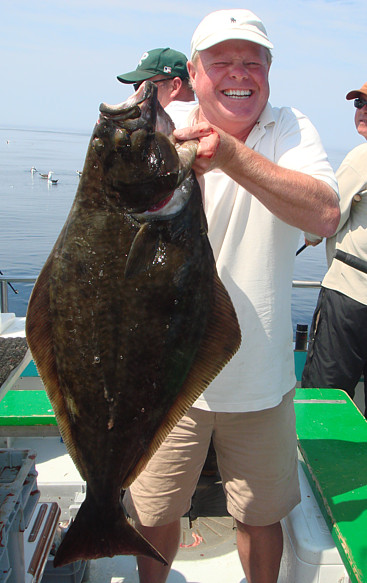 Exceptional Good Luck: During the Ultra Marathon last season, Dick Lyle (PA) got his line sawed off just as he was bringing a big fish off the bottom. Since it was pretty deep and a lot of line was out of his reel he didn't have enough main line to tie a leader to it. Dick was forced to abandon his favorite pole. We were in the middle of making two long distance drifts obliquely over a deep gravel edge. Right in the middle of the second drift, someone hooked into a rogue line that Captain Ian determined to be Dick's lost line. Not only was it Dick's lost line (a half mile from the start of the drift!) but I was able to tie it to the line (while Ian held it in his hand) on the reel of his favorite pole. And a fish was still on the jig at the end of the line! Not only that but he ended up landing the fish, a 34.5 Maine state trophy white hake, his largest fish of the trip and the sixth largest hake of the Bunny Clark fishing season! And there were all kinds of bottom dwelling animal life hooked to the exposed hooks of the treble where I could only assume the fish had tried to rub the intrusion away from the corner of its mouth. Interesting to say the least. Dick went on to catch the most good sized cod of the trip. Some of his better fish included a couple of cod over 10 pounds, a 10 pound cusk, an 11.5 pound cusk, a 25.5 pound Maine state trophy white hake, a 26 pound Maine state trophy white hake and a 17.5 pound white hake. All with just a jig on his line. It was a great day to be a Dick!
Exceptional Good Luck: During the Ultra Marathon last season, Dick Lyle (PA) got his line sawed off just as he was bringing a big fish off the bottom. Since it was pretty deep and a lot of line was out of his reel he didn't have enough main line to tie a leader to it. Dick was forced to abandon his favorite pole. We were in the middle of making two long distance drifts obliquely over a deep gravel edge. Right in the middle of the second drift, someone hooked into a rogue line that Captain Ian determined to be Dick's lost line. Not only was it Dick's lost line (a half mile from the start of the drift!) but I was able to tie it to the line (while Ian held it in his hand) on the reel of his favorite pole. And a fish was still on the jig at the end of the line! Not only that but he ended up landing the fish, a 34.5 Maine state trophy white hake, his largest fish of the trip and the sixth largest hake of the Bunny Clark fishing season! And there were all kinds of bottom dwelling animal life hooked to the exposed hooks of the treble where I could only assume the fish had tried to rub the intrusion away from the corner of its mouth. Interesting to say the least. Dick went on to catch the most good sized cod of the trip. Some of his better fish included a couple of cod over 10 pounds, a 10 pound cusk, an 11.5 pound cusk, a 25.5 pound Maine state trophy white hake, a 26 pound Maine state trophy white hake and a 17.5 pound white hake. All with just a jig on his line. It was a great day to be a Dick!
I met Ron Alpine (MA) in Breton's Bike & Fly Shop near the end of July. I was getting my racing bike tuned up. Ron was inquiring about a deep sea fishing boat to go out on. The proprietor, Claude Breton, introduced us, referencing my business as the "best on the coast". From there I would like to think that I talked Ron into fishing on the Bunny Clark. On July 29, Ron consummated his pledge to me and sailed on the full day trip with captain's Ian Keniston and Jared Keniston. He had a blast. Not only did he win the boat pool with the Bunny Clark's seventh only halibut of the season (a 25 pounder), it was Ron's first Atlantic halibut and the Bunny Clark's second largest of the fishing season! The fish was sub-legal, barely, as noted above in the trophy list. But that didn't diminish Ron's pleasure in the experience as can be seen in the picture that was taken with him holding his prize before releasing it! I was waiting for him at the dock to hear the tale when the Bunny Clark came back that day. Captain Ian sure seems to go out of his way to give anglers a good time in special circumstances!
[The picture on the left is a shot of Ron Alpine holding up his 25 pound halibut. The angler is a perfect example of why I love to take people deep sea fishing! Captain Ian Keniston digital image.]
Quotes of the Year: "We can't keep cod so cod don't exist", a comment made by Mike Schetter (NY) at the start of the Bi-annual Mike Schetter Marthon Trip Charter in June. He made the statement while deciding on the specific species that would count as a contender in the "Club" pool, alluding to the new Federal regulations prohibiting cod possession. Cod, wolffish and sharks were not considered to be viable candidates for winning the pot for the biggest fish on that trip, by "charter/club" decree. On the normal trip that we host all three species count in the boat pool. Just because the NMFS says that we can't keep them doesn't mean we can't catch them and weigh them as long as it doesn't compromise the mortality of the fish. They are still beautiful, angler worthy fish. But, each to his own, that's for sure. As it turned out that day, the largest fish was a 48 pound porbeagle shark caught by Herb Lee (NY), the second largest of that species caught for the season at that time. That fish didn't count. The second largest fish was an 18.5 pound cod caught by Ed Vross (NY). That fish didn't count in the pool either. That was the largest cod caught on the Bunny Clark for the season at that time. The third largest fish was a 17.25 pound pollock caught by Mike Ellison. Mike didn't enter the boat pool! Such is life.
"It wasn't my father!", a quote from Andrew Bruyere (NY) when I asked him who was high hook during the St. Lawrence River Rats Charter trip. I was waiting on the dock as the Bunny Clark pulled in when I asked Andrew the question. His father, Tom "Ollie" Bruyere (NY), was my roommate in college in 1970-71. We were both wise guys at the time and pestered each other continuously. The abuse still goes on today. However, now I only get to see Ollie when he charters the Bunny Clark. And, mostly, they charter the extreme day trip. I only run the marathon trips! So now I can only ladle out the abuse in short time periods when I can seize the opportunity!
Most Unusual Catch: Joe Sukatski (CT) has been fishing on the Bunny Clark for many years. In the last seven years, Joe hasn't done much on landings. In fact, he has been skunked more than once. Last year, on June 6, 2015, he had a banner day. He caught more fish on one trip than he probably has caught on all his recent trips combined! Maybe all of his trips in the last seven years! The problem was the fish he caught were all cod! All cod on the first year where there was a ban on keeping them! He was just a little less disappointed when he left the boat after that trip.
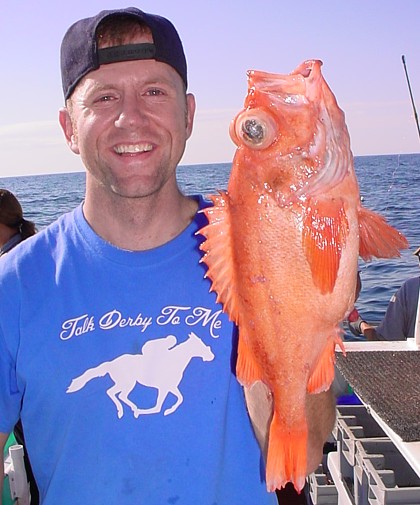 Unexplained Phenomena:
Unexplained Phenomena:
[The picture on the right shows Chris Kirste on a beautiful day during an offshore trip holding his 2.3 pound Maine state trophy redfish. It was such a great picture, I felt compelled to use it!]
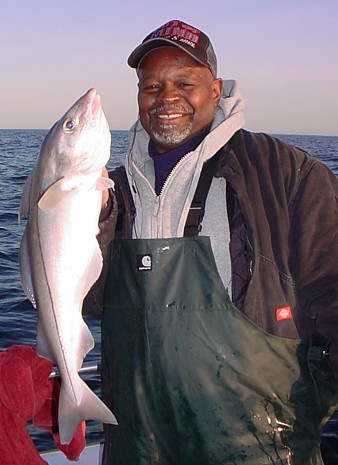
[The picture on the left was taken in early May. The digital image shows Don Stancil (PA) holding his 5.75 pound haddock which he caught that day. Probably one of the most enjoyable anglers to fish around, Don is the consummate fisherman. He loves everything about it. And the weather never bothers him. But, like everyone else, he appreciates a good weather fishing day on the ocean. The day I took the picture he had good fishing and good weather.]
In Memoriam:
We had four very important individuals pass last year. They were all people who meant a lot to me personally. And they were all people who meant a lot to the Bunny Clark as a business. Three were some of the best anglers I have ever had on the Bunny Clark. All four will be sorely missed by many.
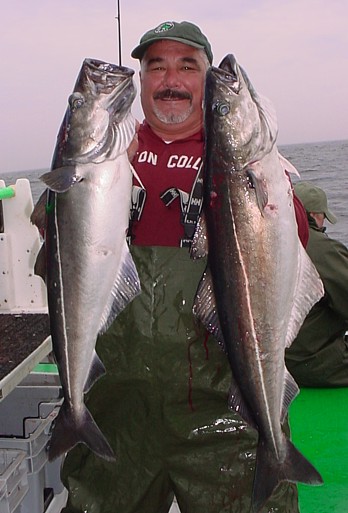
[The picture on the right is a shot of Chris Porter holding his double keeper catch of pollock caught in late May. One of these fish weighs 16 pounds while the other weighs 12.5 pounds. At the time this picture was taken, his double was the second largest double keeper catch of the Bunny Clark fishing season. It remained in the top five until June 19, 2015. Chris will be missed.]
Every year I go through the ritual of the monthly steps I take that is Bunny Clark Deep Sea Fishing. But in every business, you don't get there alone. Two of the most important people that help me with this are Captain Ian Keniston and Captain Jared Keniston. Without them, I could not provide the quality service, quality equipment, cosmetic vessel quality or quality experience. Nor would I have the time to solve the problems that arise, run the business as smoothly as I do, work on key fishery management issues or even spend as much time on this Guestletter. When I write about what I do every day in the fishing update, you can think of Jared and Ian behind the scenes doing what it takes so I can have the time, with a clear mind, to do my part. Whatever they do, I have the confidence and the peace of mind that goes along with having people you truly trust and believe in. They are actually better than that. I just can't find the words. Thank you both so much for allowing me to love my business as much as I do.
David Pease deserves a huge thank you as well. Dave was the person responsible for building the Bunny Clark to begin with. Yes, I did a lot of glass work in building the boat. But I was under Dave's instruction. And many was the time I came in the next day to fix something I did that didn't turn out as well as Dave wanted it. Dave, of course, did all the technical stuff. Last year, Dave was responsible for the new engine installation. It is the best engine installation I have ever seen in a work boat. Dave has worried about every detail that has ever been part of the physical aspects of the Bunny Clark. Whatever I dreamed of doing, he created it. This boat is highly personalized because of Dave. It's truly my boat. And he's become one of the most important men in my life. At 78 years young, he still has the happiness and drive associated with individuals who really love their work and know what the hell they are doing. Dave's the best. No one will ever convince me otherwise. I don't think anyone would ever try.
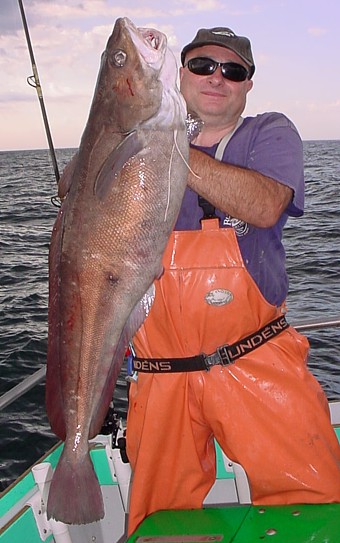 Alec Levine also deserves a thank you. Alec was our swing deck hand and newest captain, making Captain by the end of the summer. He was my deck hand on the Tim Tuesday summer day trips, evening trips and special offshore trip. He also worked under Ian and Jared. Whatever I wanted to do, his attitude was; "Lets do it!". Hard worker, good boat handler, great with the people and great attitude. That's what I wanted and that's what I got with Alec. Right now it is uncertain as to whether he will be with us this season. There is going to be a time when he will want to strike out on his own. And it might be this year. I will know for sure later. If he doesn't come back, I will always be appreciative of the great things he did for us. Thanks, Alec!
Alec Levine also deserves a thank you. Alec was our swing deck hand and newest captain, making Captain by the end of the summer. He was my deck hand on the Tim Tuesday summer day trips, evening trips and special offshore trip. He also worked under Ian and Jared. Whatever I wanted to do, his attitude was; "Lets do it!". Hard worker, good boat handler, great with the people and great attitude. That's what I wanted and that's what I got with Alec. Right now it is uncertain as to whether he will be with us this season. There is going to be a time when he will want to strike out on his own. And it might be this year. I will know for sure later. If he doesn't come back, I will always be appreciative of the great things he did for us. Thanks, Alec!
My commander in chief of Bunny Clark land based operations, Deb, my wife, is the glue that holds all this stuff together. So far, to my great delight, she still likes me enough to have me around. She does all the bookwork, keeps me in line, manages all the reservationists, is the first one to take reservations at the start of every year, gives me good advice and keeps me going and doing what I should be doing. She also takes me on vacations and encourages me to take time off. Personally, she does much more for me than I can write about here. And you probably wouldn't want to hear about those things anyway. Thank you, Deb. Just another person I could not live without in this business and a person I just couldn't live without.
[The digital image on the left shows one of the best anglers to ever walk aboard the Bunny Clark, Fred Kunz (NH), holding his 26 pound Maine state trophy hake which he caught with me during an offshore marathon trip in August. Fred has taken six Fisherman of the Year awards since he first started fishing with me in the '90s. The trophy list just wouldn't be the same if it were not for my regular anglers like Fred!]
Jane Staples is our next in command ashore. A wonderful person and reservationist as well, Jane grew up a few houses down from where I grew up. We live closer together now. So not only did she know me from the beginning, she knew what to expect from the beginning. And it was no surprise to me that she does such a good job. Part of doing business in a town is knowing the local population and how it works. She does. Also, Jane always takes over without a question when needed. And she gets involved in the office work and the day to day. Thank you, Jane. Iím so glad you are here - still, after all these years. This is a repeat paragraph from last season's Guestletter but no less meaningful and true.
We engaged three of the "old guard" reservationists last season. They included the good Commander, Deb, wonderful Jane and my daughter, Halley. Halley was pinned out of Nursing School at Fairfield University last May where she graduated with a BS. Later, last summer, she passed her boards and became on official RN at twenty-two years old. Do I sound like a proud father? I am! She now lives in an apartment in the south end of Boston works as a nurse for Dr. Daniel Steinberg, an allergist with an office in Chestnut Hill. Halley stayed at home last year when she was studying for her boards. And she continued as a reservationist for us while she was here. She is wonderful at that job, if I do say so myself. She is bright, gregarious, happy and very engaging with our patrons and people in general. I will miss her this summer as she continues working in her vocation. Thank you, Halley, for being you and doing such a good job for us over the years. Miss you, I will, greatly.
Three of our newer reservationists, twins, Shae & Nikki Smith (ME), seventeen years old, and Charlotte Tragard (a very close family friend from Ogunquit) found their way back with us again - thank God! Shae & Nikki worked weekends and were much improved over the previous year. It was their first year, last, and their first job. They were shy, a bit, at first but opened up to the public in a big way last season. I am hoping they will be back. Charlotte is self employed as well as working for us and watching the house when we need her to. She is a bit younger than Deb and I, mostly I! But she has the people skills that would make her a good President if she ever got the chance! She was very good last year, as always. Thanks, Charlotte, Nikki and Shae! I really hope you are all back with us this coming year.
This was my ninth season riding in the Pan-Massachusetts Challenge (PMC), an 192 mile, two day, cycling event that takes place the first Saturday of every August. The purpose of the event is to raise money for cancer research and care at the Dana-Farber Cancer Institute (DFCI), Boston, Massachusetts. I ride in the event and am sponsored for doing so with donations from anyone I can convince to give me funding. All the money goes to the Jimmy Fund, the fund raising arm of the DFCI, founded in 1948. At the time of this writing I have moved $239,208.77 in donations to the Jimmy Fund since 2007. Last year, I raised $25,537.00 from 215 donations. This was down from other years primarily because most of the donors are patrons of the Bunny Clark. We didn't take as many passengers last season. Still I get a lot of support from my anglers. For this I am deeply grateful. I have already renewed my application for the 2016 PMC and have raised $6,535.00 at this time.
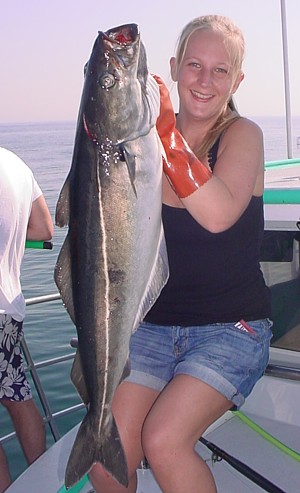 I am looking forward to raising as much money as I can in a push to get over the quarter million dollar mark, which I fully expect to do as long as I survive my winter training rides! The money raised helps to maintain the most wonderful cancer facility in the country right in our own back yard. In the last few years I found that nine people became cancer free because of my direct involvement in the DFCI. They were going to be treated elsewhere until my writings changed their minds. Three people told me only after they became cancer free the year before, even though they had started treatment months before! I will continue to support the DFCI because of their track record, the fact that 100% of your donation goes directly to the DFCI (the United Way, for instance, reserves more than 28% of your donation for administrative costs - and the United Way is considered one of the best charities) and because the more money they receive the better their chances are of hiring the best researchers. I hope you can help me celebrate the joy I get from supporting a great cause at a wonderful place in the form of a future donation. Otherwise, letís go fishing!
I am looking forward to raising as much money as I can in a push to get over the quarter million dollar mark, which I fully expect to do as long as I survive my winter training rides! The money raised helps to maintain the most wonderful cancer facility in the country right in our own back yard. In the last few years I found that nine people became cancer free because of my direct involvement in the DFCI. They were going to be treated elsewhere until my writings changed their minds. Three people told me only after they became cancer free the year before, even though they had started treatment months before! I will continue to support the DFCI because of their track record, the fact that 100% of your donation goes directly to the DFCI (the United Way, for instance, reserves more than 28% of your donation for administrative costs - and the United Way is considered one of the best charities) and because the more money they receive the better their chances are of hiring the best researchers. I hope you can help me celebrate the joy I get from supporting a great cause at a wonderful place in the form of a future donation. Otherwise, letís go fishing!
[The picture on the right is a shot of Morgan Palmer (ME) holding her 17 pound pollock which she caught with me during a day trip in the middle of August 2015. This pollock tied with another 17 pound pollock caught that day for the third largest fish of the trip. We caught a lot of good fish that trip on a day that was extra enjoyable in angler participation, fishing and weather. ]
I ran into John Bullard after the last NEFMC meeting. We talked for a long time. He is the Regional Administrator of the Greater Atlantic Regional Fisheries Office of the National Marine Fisheries Service (a division of NOAA) in Gloucester, Massachusetts. He is one of the most important people in the fishery management scene in New England. Our talk was mostly about recreational fishing in general and the experience of going out deep sea fishing. His point, and I couldn't agree more, was that regardless of what you catch it's the anticipation, the weather, the sea life around you, the sea state, the people on the journey with you, the hope of the catch, the feel of the ocean under the deck of a rolling boat and just holding a rod in your hand that is most important. I've always thought that a patron pays for the experience, the fish are extra! But in all seriousness, the experience is the most important. But it all boils down to what John said and what I believe. We offer the public a means to get out on the ocean and enjoy this experience. I don't want to ever lose that ability for myself or my kids and grandchildren who come after me. And don't think for a second that I will be satisfied with just being able to take anglers out fishing. I do very much want to have a healthy, sustainable stock of every species available in every size available going forward into the future. We need to preserve this for our children and our children's children.
But, the bottom line, deep sea fishing would not be nearly so grand if it were not for you allowing me to continue doing it. I can't do this without good customers. Thank you, our guests, our patrons, our anglers for allowing me to continue this life long project in the experience of deep sea fishing. Winter well! I'm very much looking forward to seeing you on the high seas this coming season!
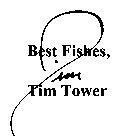
 |
If you want to send me e-mail, the current address is ttower@bunnyclark.com. My email address is sowhake@gmail.com.
With this web site in general, I hope to keep you current on all of the fishing particulars on the Bunny Clark and include updated information on fishery management decisions that could potentially affect us. For a current report go to the Fishing Update section from the link located on the index page of this web site. Thanks!